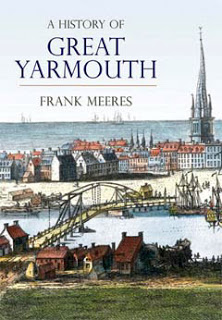by Frank Meeres
Published by Phillimore & Co at £17.99
This town has inspired some of Britain’s greatest writers and now a new book is telling Great Yarmouth’s extraordinary story.
Author Frank Meeres has invested the knowledge acquired during a decade as the borough’s archivist into The History of Great Yarmouth.
From the arrival of the first fishing huts to Scroby Sands windfarm, the book details more than a millennium of amazing change.
“Next year is the 800th anniversary of the town receiving its Royal Charter so I thought now was a good time to get a history of the borough into print,” said Mr Meeres.
“I suppose I have been researching the book for the last 10 years in my job and it took two to three years to write.”
“There were still discoveries I made while writing it that surprised me, perhaps the biggest of all was the number of people who died in the Great Plague of 1665. The town’s population was recorded as falling by 25pc during the summer of that year in the parish registers.”
“Ports like Yarmouth were particularly vulnerable to outbreaks of disease with the number of strangers coming in and most of the local plague outbreaks started in the town.”
“There was always the threat from the nature too – Yarmouth was built on a narrow spit of sand and the boundary between the sea and land has always been fragile. Dickens memorably wrote that it was mixed up like toast and water in David Copperfield.”
Fishing and then trade was the basis of the Yarmouth’s prosperity and by the Middle Ages the town was one of the richest in England.
Robinson Crusoe author, Daniel Defoe, was full of praise for the port in his book A Tour Through the Whole Island of Great Britain.
When the writer visited Yarmouth in the 1720s he was stunned by the number of boats in the harbour describing how it was possible to walk across the river on a “floating bridge” of ships.
Until the arrival of the railway in the Victorian era it was easier to transport goods by sea than land and Yarmouth had close trading links with the Low Countries.
There was a strong Dutch influence in the town with the large numbers fisherman and tradesman from Holland,” added Mr Meeres.
“Their influence was reflected in the architecture, such as Dutch gables of the Fisherman’s Hospital and the Norfolk dialect.”
“Now the outer harbour will restore that historical link and provide greater prosperity to the borough.”
It was the Georgian fashion for taking the waves that first brought the bright and breezy pleasures of the English seaside to town.
From the first few bathers the succeeding decades saw Yarmouth slowly develop into the popular tourist resort it remains to this day.
“Tourism was given an enormous boost by the arrival of railway, which enabled working class families to start visiting the town,” explained Mr Meeres.
“The peak period for visitors was probably from 1900 until the second world war, but Yarmouth still remains enormously popular – the Pleasure Beach is one of the top five visited tourist attractions in the country.
“Perhaps, as concern grows over the environment, the era of cheap flights will come to an end and more people look to reduce their carbon footprint by taking holidays closer to home.”
“I think Yarmouth has been very successful at preserving its heritage despite all the change it has seen. The town wall is one of the ten best preserved in the country and the Tolhouse is the oldest domestic building in Britain.
“Yarmouth has seen rapid expansion and periods of decline, but the town has always been able to pick itself up and start again.”









